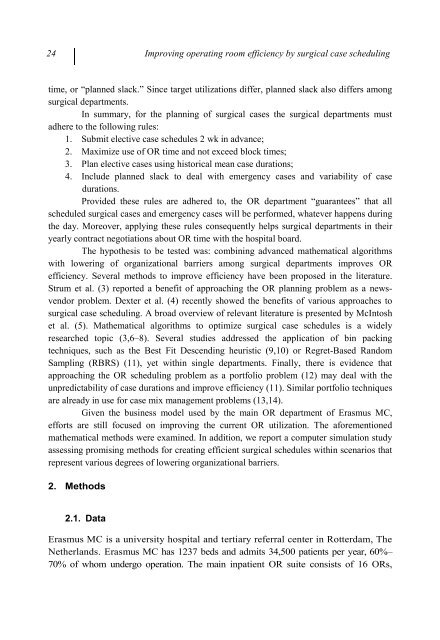Applying mathematical models to surgical patient planning
Applying mathematical models to surgical patient planning
Applying mathematical models to surgical patient planning
Create successful ePaper yourself
Turn your PDF publications into a flip-book with our unique Google optimized e-Paper software.
24 Improving operating room efficiency by <strong>surgical</strong> case scheduling<br />
time, or “planned slack.” Since target utilizations differ, planned slack also differs among<br />
<strong>surgical</strong> departments.<br />
In summary, for the <strong>planning</strong> of <strong>surgical</strong> cases the <strong>surgical</strong> departments must<br />
adhere <strong>to</strong> the following rules:<br />
1. Submit elective case schedules 2 wk in advance;<br />
2. Maximize use of OR time and not exceed block times;<br />
3. Plan elective cases using his<strong>to</strong>rical mean case durations;<br />
4. Include planned slack <strong>to</strong> deal with emergency cases and variability of case<br />
durations.<br />
Provided these rules are adhered <strong>to</strong>, the OR department “guarantees” that all<br />
scheduled <strong>surgical</strong> cases and emergency cases will be performed, whatever happens during<br />
the day. Moreover, applying these rules consequently helps <strong>surgical</strong> departments in their<br />
yearly contract negotiations about OR time with the hospital board.<br />
The hypothesis <strong>to</strong> be tested was: combining advanced <strong>mathematical</strong> algorithms<br />
with lowering of organizational barriers among <strong>surgical</strong> departments improves OR<br />
efficiency. Several methods <strong>to</strong> improve efficiency have been proposed in the literature.<br />
Strum et al. (3) reported a benefit of approaching the OR <strong>planning</strong> problem as a newsvendor<br />
problem. Dexter et al. (4) recently showed the benefits of various approaches <strong>to</strong><br />
<strong>surgical</strong> case scheduling. A broad overview of relevant literature is presented by McIn<strong>to</strong>sh<br />
et al. (5). Mathematical algorithms <strong>to</strong> optimize <strong>surgical</strong> case schedules is a widely<br />
researched <strong>to</strong>pic (3,6–8). Several studies addressed the application of bin packing<br />
techniques, such as the Best Fit Descending heuristic (9,10) or Regret-Based Random<br />
Sampling (RBRS) (11), yet within single departments. Finally, there is evidence that<br />
approaching the OR scheduling problem as a portfolio problem (12) may deal with the<br />
unpredictability of case durations and improve efficiency (11). Similar portfolio techniques<br />
are already in use for case mix management problems (13,14).<br />
Given the business model used by the main OR department of Erasmus MC,<br />
efforts are still focused on improving the current OR utilization. The aforementioned<br />
<strong>mathematical</strong> methods were examined. In addition, we report a computer simulation study<br />
assessing promising methods for creating efficient <strong>surgical</strong> schedules within scenarios that<br />
represent various degrees of lowering organizational barriers.<br />
2. Methods<br />
2.1. Data<br />
Erasmus MC is a university hospital and tertiary referral center in Rotterdam, The<br />
Netherlands. Erasmus MC has 1237 beds and admits 34,500 <strong>patient</strong>s per year, 60%–<br />
70% of whom undergo operation. The main in<strong>patient</strong> OR suite consists of 16 ORs,

















